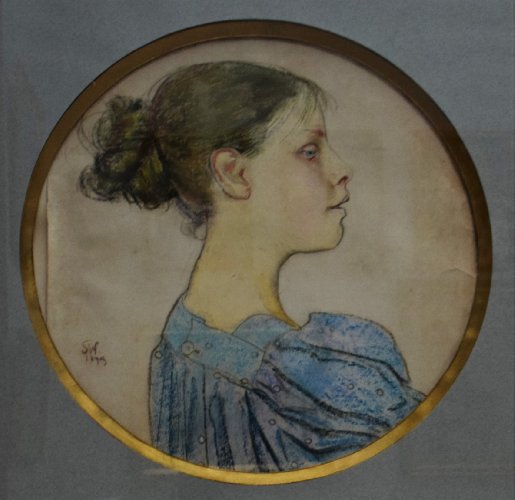Description:
Stanisław Wyspiański (1869-1907) had a large influence on the shaping of his unique and recognizable style of art, thanks to his studies in Krakow with Jan Matejko, his travels and his several-year stay in Paris with his friend Józef Mehoffer. He was particularly impressed by the works of Van Gogh, Gauguin and Toulouse Lautrec he had encountered there. Allergic to oil paint, he started using mainly pastel. Besides painting, he was engaged in graphics, decorative polychromy, stained glass, theater sets, interiors and furniture, wrote poetry and plays. His art, fitting into the program of the Young Poland, is described as symbolic, expressionistic and secessionist.
Description of the painting:
The small portrait depicts a young girl with a shapely head and a slender, long neck. The blue dress contrasts with the yellowish, unhealthy complexion, which is further emphasized by the reddening under the eyes and the pale, slightly open lips. It is likely that the girl, seen in profile, is Major Suchan’s daughter, Wyspiański’s neighbor from the house on Zacisze Street in Krakow. Perhaps she was portrayed while playing the piano during one of her visits?
The pensive face seen in a half-profile seems to pay no attention to anything around. Immersed in her own thoughts, she does not care about being portrayed, observed, does not coquette or pose for the artist in a conscious way. Her graceful head with its casual, almost careless hairstyle rises from her slender, long neck. It is difficult to determine the color of her hair, shimmering with browns, yellows, and even greens. Her arms are adorned with a blue fabric dress strangely contrasting with her yellowish, unhealthy complexion. Her deeply sunken, small eyes look down, but this absent gaze seems to be looking more at her thoughts and memories than at the reality around her. Under the raised nose, her half-open, pale lips seem to be caught in the middle of a sigh or an unsaid word.
It is difficult to tell whether the drawing was done with her permission and knowledge or whether it was a salon sketch observed quickly by the artist. There is a suspicion that the model is Major Suchan’s daughter, Wyspiański’s neighbor from the house on Zacisze Street in Krakow. Perhaps, then, the portrait was created during a neighborly visit when the major’s daughter, not paying attention to her surroundings, was absorbed in her thoughts or playing the piano? This last one can be easily imagined, observing her straight back and slightly bent head with an absent gaze.
Wyspiański’s portraits stand out for the combination of the artist’s peculiar, linear style with the simultaneous perfect rendering of both the physiognomy of the portrayed person and their state of spirit and character. The images, usually drawn with pastel, are very personal, true, and also very characteristic and recognizable. He often portrayed people from his closest circle, his friends, wife and children.
Wyspiański’s portraits were created constantly among other large projects. His inexhaustible creative force pushed him to be not only a painter or a graphic artist, but also an interior designer, furniture designer, theater set designer, stained glass designer, poet and playwright. He fit perfectly into his era and, although today we can describe his art with words such as secession, symbolism, expressionism, modernism, and consider Wyspiański as a representative of the Young Poland, he himself never liked to be labeled or classified in such systems. However, regardless of these definitions, he remains one of the most recognizable and respected artists of the turn of the 19th/20th century in Poland.


